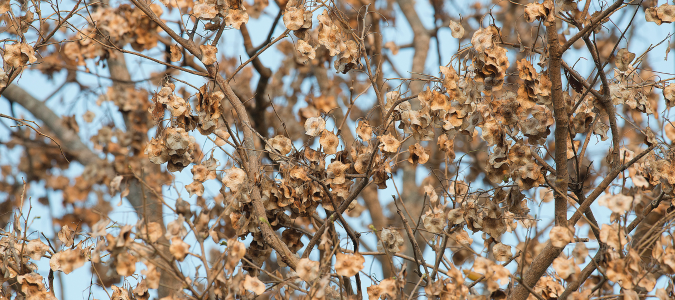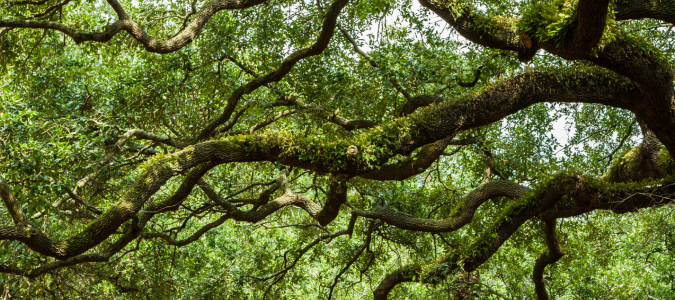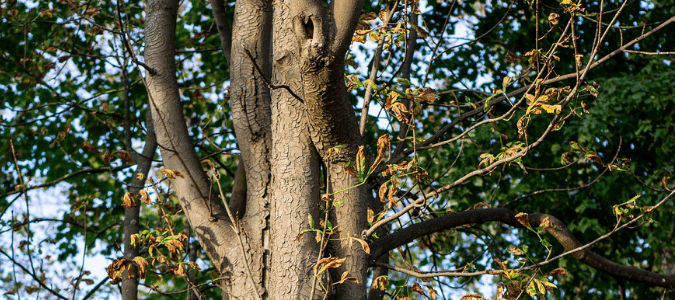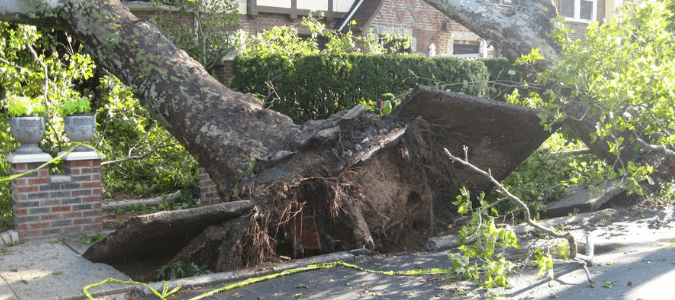Homeowners often love mature trees for their shade, beauty and boost to curb appeal and property value. But if you notice signs of a dying tree, you may wonder how to help it recover, or whether it’s time for removal.
There are a number of diseases that can infect a tree’s branches, tree roots or foliage. Because the causes of a problem can vary, it’s often best to consult a tree professional to identify the problem.
The good news is that most tree diseases cause visible symptoms that can be warning signs. This allows homeowners to act early on their trees’ behalf. Many of these signs of tree disease can look like a tree that’s just dormant, which can often make it difficult for a homeowner to tell what is actually wrong.
How To Save A Dying Oak Tree: Common Illnesses
Many types of trees, including oaks, are popular across the US for their shade and resilience. Homeowners often choose red oaks, live oaks or other oak trees for their beauty, low water needs and generous shade. In fact, the shade they offer can help lower utility bills and make spending time outside more enjoyable.
While Texas oak trees are known for being strong and sturdy, they can still be susceptible to illnesses and diseases. Some of the most common oak tree illnesses are oak leaf blister and oak wilt. A tree care expert can help you determine whether it is one of these two conditions or something else entirely that is causing your tree harm.
Oak Leaf Blisters
Oak leaf blisters can occur on most species of oak trees. These blisters are caused by a fungus known as Taphrina caerulescens.
Red oaks are especially susceptible to this disease, which causes circular, blister-like spots on the upper surfaces of the leaves. These spots might be bright green or yellow, and typically change to brown as the leaf ages. Several blisters on one leaf can merge together, causing the leaf to curl.
Fortunately, oak leaf blisters don’t threaten the tree’s overall health. They usually don’t even cause leaves to fall prematurely. However, they do affect the tree’s aesthetic appeal.
Homeowners who want to control the spread of this disease can often find success with a single use of fungicide. However, it must be applied in early spring before the tree’s buds start to open. If it’s used after new growth begins, it won’t work.
It is also helpful to rake, bag and dispose of infected leaves after they fall to help prevent the spread of this fungus. Watering and fertilizing healthy trees during drier seasons can help keep trees healthy and vigorous. This can also help make them less prone to other infections during cooler, wetter months.
Oak Wilt
Oak wilt is one of the most destructive tree diseases and can severely damage oak trees. This fungal disease interferes with the tree’s ability to absorb water. It is most likely to infect red oaks and water oaks, although any species of oak can be affected.
Live oak trees are less susceptible to oak wilt than red and water oaks. However, if they do get the disease, they’re likely to be more seriously affected because their roots are connected.
A live oak tree infected with oak wilt often has leaves with yellow veins that turn brown over time and may fall off prematurely. Red oaks may have new, young leaves in spring that quickly wilt and turn either pale green or brown. Oak wilt can also cause mature leaves to turn pale green, dark green or even bronze in color.
Some trees may develop fungal mats, a damaging fungus found beneath the bark of trees. Insects are attracted to the fungal mat’s sweet-smelling spores, which can help them expand across trees.
Oak wilt is a serious disease that can spread from one tree to other surrounding trees. Trees with oak wilt, or other advanced infections, must be treated or, in some cases, removed. If you’re unsure, a professional tree inspection can help assess the best course of action.
If you suspect your oak tree is suffering from oak wilt, it is best to consult with a tree care expert. They can help you identify the disease and develop a plan to save the tree or protect other trees nearby. They can also advise you on how to compost oak leaves.
Signs Your Tree May Be Dying
Wondering if you have a dead tree or one that just needs help? These common symptoms can help you decide whether to call in an expert for an inspection or take steps like tree pruning to improve its health. These include:
- Odd tilting
- Cankers
- Decay
- Deadwood
- Poor joints
Let’s dive into each of these a bit more.
Odd Tilting
A strong, healthy tree should stand tall, so if your tree begins to lean, it’s likely that its roots are too shallow or are losing strength. This type of damage can be caused by severe storms with lots of wind and rain, but it can also be caused by improper pruning techniques.
Cankers
Cankers are dead sections of bark. They form when fungi and bacteria infect a tree through an open wound, such as a recently cut branch. When bacteria and fungi make their way inside, they cause stress to the tree, resulting in a canker.
Decay
Decay can destroy a tree from the inside out, often starting in the tree trunk and spreading to its limbs and tree roots.
Homeowners are often unaware of decay until there are outward symptoms, like dead branches, mushroom-like growths on the tree’s bark and a shortened lifespan.
Deadwood
Having dry, easy-to-break tree branches often means your once fast-growing tree is suffering from deadwood. This infection can occur when tree branches are hollowed out by fungus, after trees have been through a strong storm or from drought that caused the bark to decay.
Poor Joints
If your tree has branches that look like they could break off at any moment, this could be an indicator that your tree is struggling due to poor joints. It’s best to call in a tree specialist for an inspection.
Is My Tree Dead Or Dormant? How To Tell The Difference
If you notice that your tree has very few leaves and doesn’t seem to be growing, you may wonder if your tree is dead or dormant. It’s easy to confuse a dying tree with a dormant one, since the symptoms can be similar.
Dormant trees are undergoing a process that is similar to hibernation. This usually happens in winter, when cold temperatures cause trees to stop growing, shed most of their leaves and stop making new ones.
The best way to know if your tree is dead or dormant is to ask a tree specialist, but you can also try a few simple tests. For example, you can try bending a twig. If it snaps easily and looks dry inside, it may be dead. The tree is likely still alive if it bends or splits to reveal green growth.
You can also try scratching the bark of a twig with your fingernail to see if there is green growth beneath the bark. If there is, the tree is likely dormant. However, if the wood underneath is brown and dry, the tree is more likely to be dying or already dead.
Signs a Tree Is About To Fall
Whether you’re dealing with a dead tree or an unstable one, signs like leaning, cracking sounds or shifting tree roots can indicate it’s time to act fast.
Just before a tree falls, you might hear a loud crackling or thunderous snapping sound from breaking roots or limbs. But are there warning signs you can spot before it gets to that point? Since falling trees and limbs can be safety hazards, it’s important to catch problems early.
This is why routine visits from a tree specialist are important to maintain the health and longevity of your trees. Tree specialists can spot tree-falling warning signs like leaning trees, weak joints or signs of fungal growth or decay. Have a tree specialist inspect your trees after strong storms or heavy winds, since these conditions can break limbs or weaken roots.
ABC Can Keep Your Trees Healthy
Regular tree inspections, tree pruning and proper care can help prevent problems before they become more difficult or expensive to manage. Whether you’re worried about dead branches, root stability or signs of a dying tree, our experts can help.
The tree care experts at ABC Home & Commercial Services can help keep your trees healthy and catch signs of disease early. We can safely remove dead or damaged limbs and provide targeted treatments for various tree issues. Leave the hard work to us, so you can sit back and enjoy the beautiful landscape of your home.




